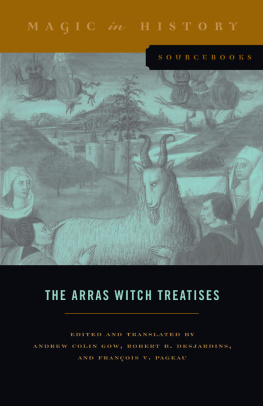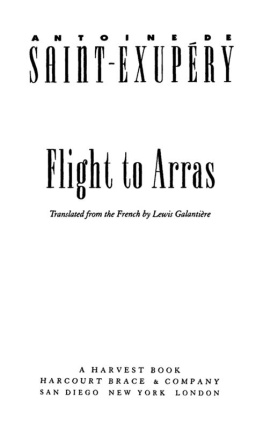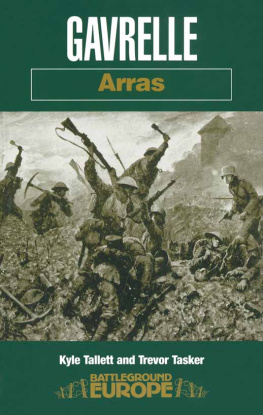The Arras Witch Treatises
MAGIC in HISTORY
SOURCEBOOKS SERIES
The Magic in History Sourcebooks series features compilations and translations of key primary texts that illuminate specific aspects of the history of magic and the occult from within. Each title is tightly focused, but the scope of the series is chronologically and geographically broad, ranging from ancient to modern and with a global reach. Selections are in readable and reliable English, annotated where necessary, with brief contextualizing introductions.
SERIES EDITORS
RICHARD KIECKHEFER, Northwestern University
CLAIRE FANGER, Rice University
The Arras Witch Treatises
Johannes Tinctors Invectives contre la secte de vauderie and the Recollectio casus, status et condicionis Valdensium ydolatrarum by the Anonymous of Arras (1460)
Edited and translated by Andrew Colin Gow, Robert B. Desjardins, And Franois V. Pageau
The Pennsylvania State University Press
University Park, Pennsylvania
Library of Congress
Cataloging-in-Publication Data
Names: Gow, Andrew Colin, editor, translator. | Desjardins, Robert B. (Robert Byron), 1969, editor, translator. | Pageau, Franois V., 1963, editor, translator. | Tinctor, Johann, approximately 14051469. Sermo contra sectam Valdensium. English. | Anonymous of Arras. Recollectio casus, status et condicionis Valdensium ydolatrarum. English.
Title: The Arras witch treatises : Johannes Tinctors invectives contre la secte de vauderie and the Recollectio casus, status et condicionis Valdensium ydolatrarum by the Anonymous of Arras (1460) / edited and translated by Andrew Colin Gow, Robert B. Desjardins, and Franois V. Pageau.
Description: University Park, Pennsylvania : The Pennsylvania State University Press, [2016] | Series: The magic in history sourcebooks series | Includes bibliographical references and index.
Identifiers: LCCN 2016002011 | ISBN 9780271071282 (pbk. : alk. paper)
Subjects: LCSH: WitchcraftFranceArrasEarly works to 1800. | DemonologyFranceArrasEarly works to 1800.
Classification: LCC BF1582 .A155 2016 | DDC 133.4/30944272dc23
LC record available at http://lccn.loc.gov/2016002011
Copyright 2016
The Pennsylvania State University
All rights reserved
Printed in the United States of America
Published by
The Pennsylvania State University Press,
University Park, PA 168021003
The Pennsylvania State University Press
is a member of the
Association of American University Presses.
It is the policy of The Pennsylvania State University Press to
use acid-free paper. Publications on uncoated stock satisfy
the minimum requirements of American National Standard
for Information SciencesPermanence of Paper for
Printed Library Material, ansi z39.481992.
CONTENTS
A History of the Case, State, and Condition of the Waldensian Heretics (Witches) (1460)
Anonymous of Arras
Invectives Against the Sect of Waldensians (Witches) (1460)
Johannes Tinctor
The project of editing and translating into English the rich and extensive collection of documents pertaining to the Vauderie dArras began in 2005, with the discovery of a manuscript copy of Johannes Tinctors Invectives contre la secte de vauderie in the Bruce Peel Special Collections at the University of Alberta. Then director Janine Green and librarian Jeff Papineau offered us extensive support and advice as we set out to analyze the codex and translate the remarkable treatise it contains. Since Janines retirement, we have been fortunate to have the assistance of Linda Quirk, the assistant director. Together with director Robert Desmarais, Linda and Jeff have supported our work in countless ways.
A number of other people have been instrumental in bringing this project to its present state. Pat Dutchak and Rhonda Kronyk both did many hours of careful work on the text of the Invectives, making a number of important discoveries about the provenance of the Alberta manuscript. Erik Kwakkel of Leiden University expertly analyzed the codex, and Paula Simons, a feature writer with the Edmonton Journal, undertook independent research to help us understand how it arrived in our city. (Her subsequent coverage informed Canadians about the significance of the treatise, and of the Vauderie dArras more generally, as did the fine documentary produced by Dave Redel of CBC Radios Ideas.) James White patiently read through our translation of the Invectives, noting a number of potential problems and errors. Jessica Roussanov offered helpful comments on our introduction, and Suzanne Wolk copyedited the final manuscript perceptively and with great care.
We would also like to acknowledge the many contributions made by students in Andrew Gows demonology seminar in the fall terms of 2013 and 2014. Matthew Punyi, Rita Neyer, Elisabeth Hill, and Jeffrey S. Longard in particular stimulated our thinking; Jeffreys extensive and thoughtful glosses on the Invectives, and on the scriptural and patristic references contained in the treatise, helped to improve and expand our explanatory references. We are grateful for all of these contributions.
Finally, we wish to thank the series editors and the many people at the Pennsylvania State University Press who have contributed to our project. It is thanks to their interest and enthusiasm that this volume is now in readers hands.
Map 1 The Duchy of Burgundy around 1460. The black lines show modern borders.
On a spring day in 1460, in the bustling city of Arras,1 in northern France, a crowd of merchants, artisans, and farmworkers gathered to witness a grim spectacle. A scaffold had been erected in the local bishops courtyard; on it stood a Dominican inquisitor and five defendants accused of spectacular crimes against the church. The prisonersfour prostitutes and an eccentric poetwere dressed in the robes of public penitents. Each wore a miter on which an image of the accused worshipping the devil had been painted.2 Nearby on the stage lay the corpse of another prisoner, a sergeant named Jean Lefebvre, who had died in jail under suspicious circumstances.3
Gesturing at the group, the inquisitor, one Pierre Le Broussard, denounced them in a loud voice. These vile women and men, he said, had been involved in vauderiediabolical witchcraft. He rattled off a list of their crimes:
When they wished to go to [worship the Devil], they anointed a small stick of wood, and their palms and their hands, with an ointment that the Devil had given them. Then they put the branch between their legs, and soon they were flying themselves... to the place where they were to have their assembly... and there they found the Devil in the form of a goat, of a dog, of an ape, and sometimes of a man.
And they... paid homage to the Devil, and adored him, and most of them gave him their souls.... [T]hen they kissed the Devil in the form of a goat on his posterior, that is, on the anus, with candles burning in their hands.... And after paying this homage, they trod upon the cross and spat upon it, in defiance of Jesus Christ and the Holy Trinity; and then they showed their anus toward the sky and the heavens, in defiance of God.4















